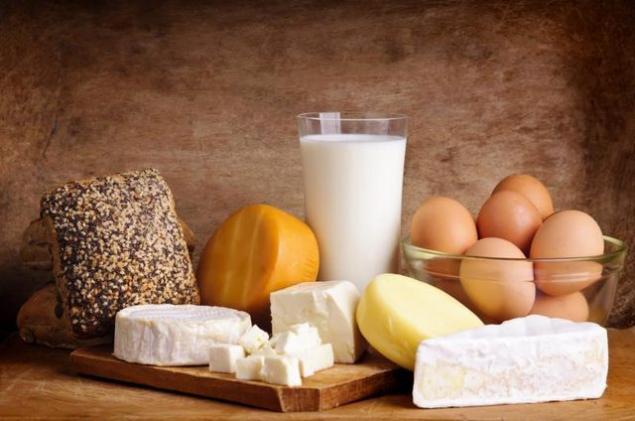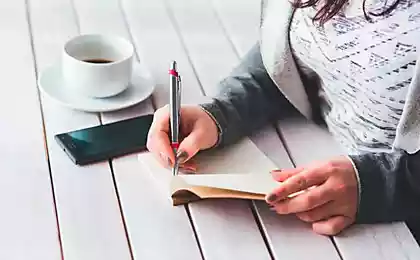697
Acidic and alkaline food: what you need to know
What products are acidic and which are alkaline, the difference between them, and how they affect human health? Human blood is alkaline in nature. To maintain the alkalinity of the blood we need 80% alkaline foods and 20% acidic. After completing a full cycle of digestive and metabolic processes in the body some foods leave an alkaline wastes, while others leave acidic. We may call such foods alkali-genic and acid-genic respectively.

Usually acid synthesized during the metabolic products (e.g., uric acid, lactic acid, etc.), enter into a chemical reaction with the alkalis of the blood, lymph, bile, etc., neutralizes in the end. But if the diet is dominated by acid-genic foods, the body cannot cope with all incoming acids, and then begin to show symptoms: fatigue, headache, loss of appetite (anorexia), insomnia, nervous tension, giperatidnosti, runny nose, etc.
There are other important side effects arising from increased acidity of the blood. The body uses sodium as a buffer to maintain homeostasis and return the acidic pH factor to normal levels, resulting in reserves of sodium are exhausted. When sodium is no longer able to buffer the accumulated acid as the second buffer, the body begins to use the calcium. Calcium is leached from bones and teeth, if not supplied with power. This leads to a weakening of the bones, which become porous and brittle. This condition in medical language is called osteoporosis.
Chronic acidity is an abnormal condition in which accelerate the processes of degeneration and aging. All toxic substances in the body are in the form of acids, and to prevent or counteract the accumulation of acids in the body, we must consume foods that are mostly alkaline in nature.
Therefore, it is important to know what foods are acidic and which are alkaline. Depending on the impact of food on the urine, they are divided into acid - or alkali-genic. Calcium, magnesium, sodium, iron, copper, manganese and potassium contained in food, are creating an alkaline effects. Sulfur, phosphorus, chlorine, iodine, carbon dioxide and coal, lactic and uric acid in foods create an acidic effect.

List of acidic products
1. All foods of animal origin: meat, eggs, fish, poultry, etc.
2. Dairy products: UHT and pasteurized milk, cheese, cottage cheese and butter.
3. Dried peas and beans.
4. All cereals and legumes: wheat, corn, rice and beans.
5. All nuts and seeds (dried): peanut, walnut, cashew, sesame, sunflower, melon seeds.
6. All finished products and semi-finished products: white bread, buns, bakery products, white flour, polished rice, white sugar.
7. Toxic products: tea, coffee, alcohol, tobacco, soft drinks.
8. All fats and oils.
9. All fried and spicy foods.
10. All sweet products and sweets containing white sugar).
A list of alkaline foods.
1. All fruits (fresh or dried), including citrus fruits.
2. All fresh green vegetables and root vegetables (except peas and beans).
3. Sprouts of beans, peas, cereal grains and seeds.
4. Germinated grains and legumes ??
Partially alkaline foods
1. Fresh raw milk and cheese.
2. Soaked nuts and seeds.
3. Fresh nuts: almonds, coconut, Brazil nut.
4. Fresh green beans, peas, corn and millet.
Some useful comments
1. As can be seen in the table, wheat wholemeal flour, unpolished rice and other cereals in their natural form are moderately acid, but after treatment or cleaning become more acidic.
2. Almost all cereals, beans, all kinds of meat, eggs and fish are acidic in nature, while almost all fruits and vegetables are alkaline.
3. All citrus fruits (lemon, orange) initially seem sour, but their final effect in the body is alkaline. That is why they are classified as alkaline foods.
4. Indigestible fruits legumes belong to the category of acidic foods, but by germinating become more alkaline and less acidic.
5. There is little doubt in the acidic or alkaline nature of milk. In this regard, it should be noted that fresh raw milk is alkaline, while heated or boiled milk is sour. Various products derived from milk, such as cheese, butter etc. are also acidic in nature.
6. Among nuts, peanuts is the most acid-genic, whereas almonds are the least acid-genic. Coconut, on the other hand, is alkaline in nature.
Recorded
Jur
Global moderator
Veteran
The division of food acidic and alkaline produced by the yogis long ago. To acidic include all animal products, many tarnowie, especially cleaned, dried bean, cheese, cheese. Alkaline foods — vegetables, fruits, nuts (except peanuts), herbs, milk, yogurt, yogurt.
In Europe it was first noticed over 100 years ago German scientist R. Berg. He proved that the optimal for the body is maintaining an alkaline internal environment, which largely is achieved by the selection of appropriate products.
According to yogis, it is necessary that during the day one part acidic food accounted for at least two parts alkaline. Alkaline internal environment characteristic of healthy people and ensures the effective functioning, reduces the need for protein, gives strength and longevity. Prolonged acidification brings diseases, and premature decrepitude.
Scientists N. Walker and R. Pope appreciated the number of products in connection with their ability to oxidize or oxalacetate the body.
"+" — weak alkalization; " - " for weak oxidation;
"++" — average alkalization; "- -" — secondary oxidation;
"+++" — strong alkalization; "- — - " a strong oxidation;
"++++ " a very strong alkalization, etc.
The alkalinity of the internal environment contribute to the cations of acids — calcium, magnesium, potassium, sodium. Acidification also cause anions containing phosphorus, sulfur, chlorine.
Alkaline environment in the body promotes good health, but this does not mean that you should go on eating only alkaline foods. Anywhere in harmony, so it is best to adhere to the ratio of "one part of acid food — part two alkaline"!
Fruit
Fresh apricots +++
Peaches +++
Dried apricots ++++
Dried plums —
Watermelons +++
Pickled plum —
Ripe bananas ++
Currant +++
Green bananas —
Lemon juice, fresh +++
Grapes ++
Lemon juice with sugar
Grape juice ++
Orange juice, fresh +++
Grape nectar
Dates ++
Cherry ++
Almost all fruits +++
Melon +++
The fruit, boiled with sugar from — to —
Raisins ++
Prunes ++
Figs dried ++++
Fresh apples ++
Cranberry +
Dried apples ++
Vegetables and cereals
Potatoes with peel +++
Peanuts
Carrots ++++
Almonds ++
Pepper +++
Starch —
Fresh tomatoes ++++
Hominy and corn flakes —
Radishes +++
Oatmeal +++
Beets fresh ++++
Barley grits —
Beans fresh +++
White flour —
Beans, dried —
Black bread —
Baked beans —
White bread —
Green peas ++
Dry peas —
Products of animal origin
Whole milk +++
Lamb cooked —
Whey +++
Lamb stew —
Cream —
Lean ham fresh
Cheese —
Bacon fat —
Soft cheese — Bacon skinny —
Eggs --
Lean pork —
Beef —
Pork fat +
Veal —
Fish from — to —
Beef liver —
Halibut —
Game --
Cancers --
Chickens
Oysters --
Mussels —
P. S. And remember, only by changing their consumption — together we change the world! ©
Source: glubinnaya.ru/archives/3945

Usually acid synthesized during the metabolic products (e.g., uric acid, lactic acid, etc.), enter into a chemical reaction with the alkalis of the blood, lymph, bile, etc., neutralizes in the end. But if the diet is dominated by acid-genic foods, the body cannot cope with all incoming acids, and then begin to show symptoms: fatigue, headache, loss of appetite (anorexia), insomnia, nervous tension, giperatidnosti, runny nose, etc.
There are other important side effects arising from increased acidity of the blood. The body uses sodium as a buffer to maintain homeostasis and return the acidic pH factor to normal levels, resulting in reserves of sodium are exhausted. When sodium is no longer able to buffer the accumulated acid as the second buffer, the body begins to use the calcium. Calcium is leached from bones and teeth, if not supplied with power. This leads to a weakening of the bones, which become porous and brittle. This condition in medical language is called osteoporosis.
Chronic acidity is an abnormal condition in which accelerate the processes of degeneration and aging. All toxic substances in the body are in the form of acids, and to prevent or counteract the accumulation of acids in the body, we must consume foods that are mostly alkaline in nature.
Therefore, it is important to know what foods are acidic and which are alkaline. Depending on the impact of food on the urine, they are divided into acid - or alkali-genic. Calcium, magnesium, sodium, iron, copper, manganese and potassium contained in food, are creating an alkaline effects. Sulfur, phosphorus, chlorine, iodine, carbon dioxide and coal, lactic and uric acid in foods create an acidic effect.

List of acidic products
1. All foods of animal origin: meat, eggs, fish, poultry, etc.
2. Dairy products: UHT and pasteurized milk, cheese, cottage cheese and butter.
3. Dried peas and beans.
4. All cereals and legumes: wheat, corn, rice and beans.
5. All nuts and seeds (dried): peanut, walnut, cashew, sesame, sunflower, melon seeds.
6. All finished products and semi-finished products: white bread, buns, bakery products, white flour, polished rice, white sugar.
7. Toxic products: tea, coffee, alcohol, tobacco, soft drinks.
8. All fats and oils.
9. All fried and spicy foods.
10. All sweet products and sweets containing white sugar).
A list of alkaline foods.
1. All fruits (fresh or dried), including citrus fruits.
2. All fresh green vegetables and root vegetables (except peas and beans).
3. Sprouts of beans, peas, cereal grains and seeds.
4. Germinated grains and legumes ??
Partially alkaline foods
1. Fresh raw milk and cheese.
2. Soaked nuts and seeds.
3. Fresh nuts: almonds, coconut, Brazil nut.
4. Fresh green beans, peas, corn and millet.
Some useful comments
1. As can be seen in the table, wheat wholemeal flour, unpolished rice and other cereals in their natural form are moderately acid, but after treatment or cleaning become more acidic.
2. Almost all cereals, beans, all kinds of meat, eggs and fish are acidic in nature, while almost all fruits and vegetables are alkaline.
3. All citrus fruits (lemon, orange) initially seem sour, but their final effect in the body is alkaline. That is why they are classified as alkaline foods.
4. Indigestible fruits legumes belong to the category of acidic foods, but by germinating become more alkaline and less acidic.
5. There is little doubt in the acidic or alkaline nature of milk. In this regard, it should be noted that fresh raw milk is alkaline, while heated or boiled milk is sour. Various products derived from milk, such as cheese, butter etc. are also acidic in nature.
6. Among nuts, peanuts is the most acid-genic, whereas almonds are the least acid-genic. Coconut, on the other hand, is alkaline in nature.
Recorded
Jur
Global moderator
Veteran
The division of food acidic and alkaline produced by the yogis long ago. To acidic include all animal products, many tarnowie, especially cleaned, dried bean, cheese, cheese. Alkaline foods — vegetables, fruits, nuts (except peanuts), herbs, milk, yogurt, yogurt.
In Europe it was first noticed over 100 years ago German scientist R. Berg. He proved that the optimal for the body is maintaining an alkaline internal environment, which largely is achieved by the selection of appropriate products.
According to yogis, it is necessary that during the day one part acidic food accounted for at least two parts alkaline. Alkaline internal environment characteristic of healthy people and ensures the effective functioning, reduces the need for protein, gives strength and longevity. Prolonged acidification brings diseases, and premature decrepitude.
Scientists N. Walker and R. Pope appreciated the number of products in connection with their ability to oxidize or oxalacetate the body.
"+" — weak alkalization; " - " for weak oxidation;
"++" — average alkalization; "- -" — secondary oxidation;
"+++" — strong alkalization; "- — - " a strong oxidation;
"++++ " a very strong alkalization, etc.
The alkalinity of the internal environment contribute to the cations of acids — calcium, magnesium, potassium, sodium. Acidification also cause anions containing phosphorus, sulfur, chlorine.
Alkaline environment in the body promotes good health, but this does not mean that you should go on eating only alkaline foods. Anywhere in harmony, so it is best to adhere to the ratio of "one part of acid food — part two alkaline"!
Fruit
Fresh apricots +++
Peaches +++
Dried apricots ++++
Dried plums —
Watermelons +++
Pickled plum —
Ripe bananas ++
Currant +++
Green bananas —
Lemon juice, fresh +++
Grapes ++
Lemon juice with sugar
Grape juice ++
Orange juice, fresh +++
Grape nectar
Dates ++
Cherry ++
Almost all fruits +++
Melon +++
The fruit, boiled with sugar from — to —
Raisins ++
Prunes ++
Figs dried ++++
Fresh apples ++
Cranberry +
Dried apples ++
Vegetables and cereals
Potatoes with peel +++
Peanuts
Carrots ++++
Almonds ++
Pepper +++
Starch —
Fresh tomatoes ++++
Hominy and corn flakes —
Radishes +++
Oatmeal +++
Beets fresh ++++
Barley grits —
Beans fresh +++
White flour —
Beans, dried —
Black bread —
Baked beans —
White bread —
Green peas ++
Dry peas —
Products of animal origin
Whole milk +++
Lamb cooked —
Whey +++
Lamb stew —
Cream —
Lean ham fresh
Cheese —
Bacon fat —
Soft cheese — Bacon skinny —
Eggs --
Lean pork —
Beef —
Pork fat +
Veal —
Fish from — to —
Beef liver —
Halibut —
Game --
Cancers --
Chickens
Oysters --
Mussels —
P. S. And remember, only by changing their consumption — together we change the world! ©
Source: glubinnaya.ru/archives/3945























